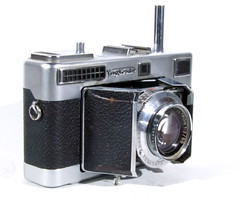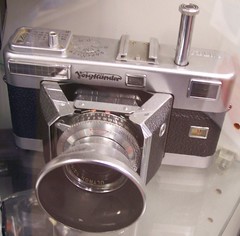
|
| Voigtländer Vitessa L Image by Uwe Kulick (Image rights) |
The Vitessa was an innovative 35mm folding rangefinder camera made by Voigtländer in the 1950s. The conventional folding bed was replaced by a barn-door assembly, the focusing was operated by the user's right thumb via a wheel on the back of the top plate, with a distance dial (and depth-of-field scale) set into the top plate. The film advance and shutter cocking were operated with a "Kombi-Plunger;" a large rod protruding from the top plate, that could be retracted when the camera was folded.
The Vitessa underwent a number of small variations during its production. The very first models did not have strap lugs nor automatic parallax correction. The most expensive models featured a 50mm f/2 Ultron lens set in a Compur-Rapid shutter. The others had a 50mm f/3.5 or f/2.8 Color-Skopar set in a Synchro Compur shutter. Both shutters achieved speeds from 1 to 1/500th of a second. The later models had an uncoupled selenium meter, and the final models lacked the folding mechanism but added interchangeable lenses.
Vitessa shows a superb, almost Leica M3 quality fit and finish. Metered models use Exposure Value settings, a system popular in the 1950's. Its design and mechanics are unique in its class, like Voigtlander Prominent's unique design. Voigtlander Vitessa L was named the most elegant 35mm folder camera by Stephen Gandy. But many photographers and collectors place pre-metered models at a higher value for their smaller numbers, clean aesthetics and lack of timely electronics. The Vitessa range has several versions and models. There are several nicknames of Vitessa, eg. in German it was called the Leuchtturm, means The Lighthouse named after the unique plunger rod.
The unique front covers are usually referred to as the "barn-doors".
At the end of the 1960s, Zeiss Ikon / Voigtländer produced a series of compact 35mm cameras called the Vitessa 500, and some 126 film cameras called the Vitessa 126, that are both discussed elsewhere.
Voigtländer Vitessa models[]
There are four principal Vitessa models.[1] [2]
Voigtländer Vitessa A[]
- Produced between 1950-54
- There are 5 versions
Vitessa A version 1, 1950[]
- Shutter: Compur-Rapid or Synchro-Compur leaf shutter, 1-1/500
- Lens: 50mm f2 Ultron or 50mm f2.8 or f3.5 Color-Skopar
- Flash PC socket on the lens, old type
- Back cover: not fully removable, film pressure plate connected to body, not to back cover
- Removable accessory shoe
- Strap lugs: none
- "Voigtländer VITESSA" engraved paint-filled scripting on top of the top plate

|
| Voigtländer Vitessa A version 1 Image by David Broglin (Image rights) |
Vitessa A version 2, 1951[]
- Filter: screw thread
- Manual parallax correction
- Shutter: Compur-Rapid or Synchro-Compur leaf shutter, 1-1/500
- Lens: 50mm f2 Ultron or 50mm f2.8 or f3.5 Color-Skopar
- Flash PC socket on the lens, old type
- Back cover: removable and with pressure plate connected to it
- Cold shoe: none
- Strap lugs: none
- "Voigtländer VITESSA" engraved paint-filled scripting on top of the top plate
Photo in Corsopolaris
Vitessa A version 3, 1952[]
- Automatic parallax correction
- Shutter: Compur-Rapid or Synchro-Compur leaf shutter, 1-1/500
- Lens: 50mm f2 Ultron or 50mm f2.8 or f3.5 Color-Skopar
- Flash PC socket on the lens, old type
- Back cover: removable and with pressure plate connected to it
- Cold shoe: none
- Strap lugs
- "Voigtländer VITESSA" engraved paint-filled scripting on top of the top plate
Photo in Corsopolaris
Vitessa A version 4, 1953[]
- Automatic parallax correction
- Shutter: Compur-Rapid or Synchro-Compur leaf shutter, 1-1/500
- Lens: 50mm f2 Ultron or 50mm f2.8 or f3.5 Color-Skopar
- Flash PC socket on the barn door, modern type
- Back cover: removable and with pressure plate connected to it
- Cold shoe: Removable
- Strap lugs
- "Voigtländer VITESSA" engraved paint-filled scripting on top of the top plate
Photo in Corsopolaris
Vitessa A version 5, 1954[]
- Automatic parallax correction
- Shutter: Compur-Rapid or Synchro-Compur leaf shutter, 1-1/500
- Lens: 50mm f2 Ultron or 50mm f2.8 or f3.5 Color-Skopar
- Flash PC socket on the barn door, modern type
- Back cover: removable and with pressure plate connected to it
- Cold shoe: Integrated
- Strap lugs
- "Voigtländer" engraved paint-filled scripting on front of the top plate
- "VITESSA" stamped on top of the top plate
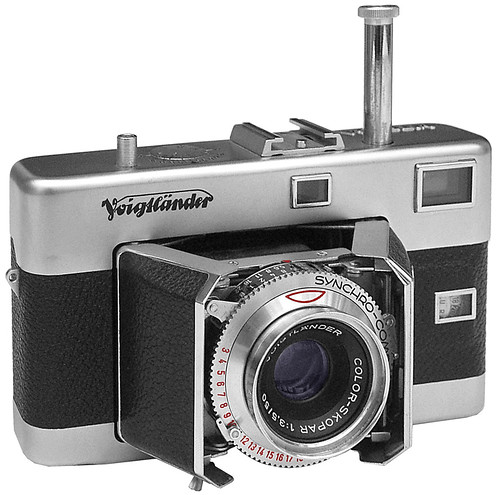
|
| Voigtländer Vitessa A version 5 (c.1956) early model without meter, w/Color-Scopar 50mm f/3.5 by Alf Sigaro (Image rights) |
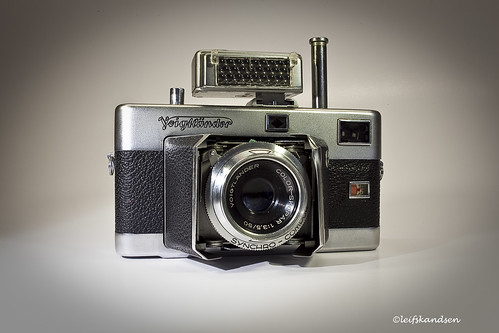
|
| Voigtländer Vitessa A version 5 w/ external light meter on the accessory shoe (1954) Image by Leif Skandsen (Image rights) |
Voigtländer Vitessa N[]
- Introduced in 1954
- There are 2 versions
- Filter: bayonet mount
- Synchro-Compur LVS shutter
- EV 3-18
- Self-timer
- Flash PC socket on the barn door
- Automatic parallax correction
- Strap lugs
- Fixed accessory shoe
- Lenses Ultron 50mm f/2 and Color-Skopar 50mm f/3,5
Vitessa N version 1[]
- Speeds ring & aperture ring not coupled
- External rangefinder window square
Photo in Corsopolaris
Vitessa N version 2[]
- Speeds ring & aperture ring coupled
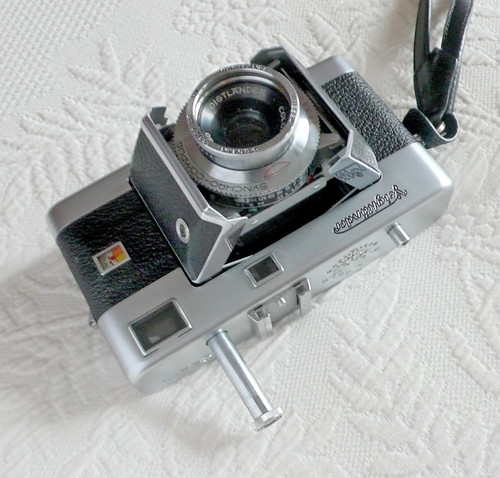
|
| Voigtländer Vitessa N version 2 Image by Matt Phillips (Image rights) |
Voigtländer Vitessa L[]
- Produced between 1954-57
- There are 5 versions
- Bayonet filter mount
- Synchro-Compur LVS shutter 1-1/500
- Self-timer
- Flash PC socket on the barn door
- Automatic parallax correction
- Strap lugs
- Fixed accessory shoe
- Incorporated meter ABCDEF ASA 6-200 (last models BCDEFG ASA 12-400)
Vitessa L version 1[]
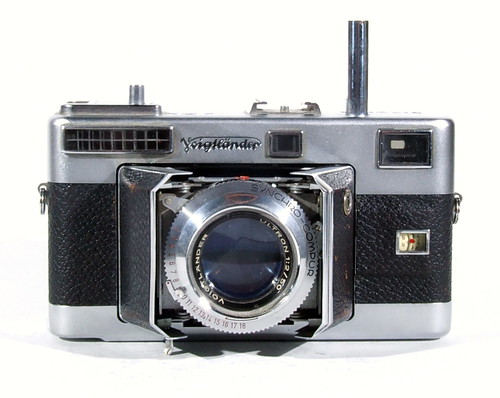
|
| Voigtländer Vitessa L version 1 (1955) w/Ultron 50mm f/2.0, with meter by Süleyman Demir (Image rights) |
Vitessa L version 1 specifications[]
- Lens: Ultron 50mm f/2.0, six element, screw filter mount
- Aperture: f/2 - f/22, setting: dial and manual setting lever on the lens-shutter barrel
- Focus range: 3.3 - 60 feet (1-18m) +inf
- Focus distance and DOF scale: a rotating dial when focusing, on the top plate
- Focusing: match the rangefinder images in the finder
- Via a thumb wheel on back right side of the top plate
- Shutter: Synchro-Compur leaf shutter, speeds: 1-1/500 +B
- Aperture and speeds are coupled and turning the speeds ring also turns the aperture setting
- Exposure meter: Selenium cell
- Flat chequered (square) window
- Based on the Exposure Value, needle window on the right of the top plate
- Metering range 6-200 ASA (EV 2-19)
- Exposure setting: after reading your film's ASA's corresponding letter from the plate which shows A to F letters near the needle window
- Set this letter to EV number dial in the window turning the knob on the back far right side of the top plate,
- Then read the EV that matches with the needle and apply this EV number to the EV numbers dial by turning the speeds ring for the correct exposure
- If the EV is out of the speeds range, turn and set again the aperture manually by lifting its lever to fit exact EV
- EV numbers dial: accordig to combined aperture-speed settings is on front of the lens-shutter barrel, aperture setting lever points them
- Cocking device: a long Combi-plunger rod, also winds the film, on left side of the top plate,
- Always depress the Combi-plunger as far as it will go and then let it come out completely, could be retracted when the bellows-doors closed, push down until it clicks
- Frame counter: advance type, manual setting when the back cover removed
- The frame count is in a window on left front of the camera,
- Shutter release: on the top plate, right side, w/ cable release socket
- View finder: coupled viewfinder/rangefinder, Parallax corrected
- Re-wind: a folding lever on the bottom plate, right side
- Its shaft has a small red line on it., and must rotate once when advancing the film
- Re-wind release: a small knob, on the bottom plate
- Flash PC socket: on the left side of the bellows-door, synchro. all speeds,
- X and M settings via the MXV lever and dial on the lens-shutter barrel
- Self-timer: setting via MXV lever and dial on the lens-shutter barrel, V for the self-timer
- Opening the bellows-doors: pressing the shutter release, cocking plunger will raise also
- Closing the bellows: pushing simutaneously onto the red semi-lunar pressure marks on front of the lens, on 12 and 6 o'clock
- There is a small folding supporter piece for standing straight of the camera, just beneath the right door
- Back cover: removable, completely detaches with bottom plate and front plates of the body, opens via a folding latch on center of the bottom plate, turns 90 degrees
- Others: Memory dial; Cold-shoe; Tripod socket 1/4inch; Strap lugs
- Body: Metal; weight: 691g
|
|
| ||||||
| Voigtländer Vitessa L version 1 (1955) w/Ultron 50mm f/2.0
Images by Süleyman Demir (Image rights) | ||||||||
Vitessa L version 2[]
- Shutter: Synchro-Compur 1-1/500 (on all versions of Vitessa L)
- Light meter's window texture: bubble
- Metering range: 6-200 ASA (EV 2-19)
Photo in Corsopolaris
Vitessa L version 3[]
- Light meter's window texture: bubble
- Metering range: 12-400 ASA
Vitessa L version 4[]
- Lens: Color-Skopar f/2.8
- Light meter's window texture: flat chequered
- Metering range: 6-200 ASA (EV 2-19)
Photo in Corsopolaris
Vitessa L version 5[]
- Light meter's window texture: flat chequered
- Metering range: 6-200 ASA (EV 2-19)
Voigtländer Vitessa T[]

|
| Voigtländer Vitessa T w/Cassarit lens Image by David Broglin (Image rights) |
The folding Vitessa was replaced by the rigid Vitessa T. It was based on the folding Vitessa models, and retained their basic body but without the barn-door, their rangefinder, uncoupled selenium meter and the plunger rod advance mechanism. But the Vitessa T had a rigid body, and interchangeable lenses in front of a Synchro-Compur leaf shutter. Focusing is by a ring around the lens, as usual but unlike the folding Vitessa that have a wheel operated by the right thumb.
- There are 3 versions
- Introduced in 1957
- Lenses: Interchangeable, Vitessa T original lens range was quite limited
- Color-Skopar 50/2.8 standard lens
- Skoparet 35/3.4 wide angle lens
- Dynaret 100/4.8 medium tele lens
- Super-Dynaret 135/4 tele lens
- But all the lenses made for the Braun Super Colorette can be used on the Vitessa T, like Steinheil Cassarit 50/2.8
- Shutter: Synchro-Compur leaf shutter 1-1/500
- Self-timer
- Flash PC socket: on front of the camera
- Automatic parallax correction
- Sometimes with strap lugs sometimes not
- Cold shoe
- Incorporated meter ABCDEF ASA 6-200 (last models BCDEFG ASA 12-400)
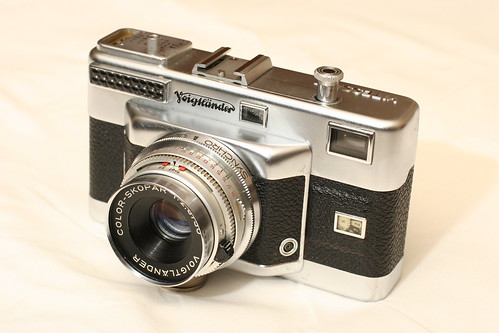
|
| Voigtländer Vitessa T w/Color-Scopar 50mm f/3.5 by Lightshaper (Image rights) |
Notes and references[]
- ↑ In this page Vitessa series classification, typing and info are according to Massimo Bertacchi[1]
- ↑ These Vitessa models are also called type 125, 133, 140 and 134 in p.964 of McKeown, James M. and Joan C. McKeown's Price Guide to Antique and Classic Cameras, 12th Edition, 2005-2006. USA, Centennial Photo Service, 2004. ISBN 0-931838-40-1 (hardcover). ISBN 0-931838-41-X (softcover).
Links[]
General links[]
In English:
In German:
- Vitessa and Vitessa T pages at Dietrich Drescher's Voigtländer website
- Vitessa at Peter Lausch's camera site
In French:
- On www.collection-appareils.fr by Sylvain Halgand :
In Japanese:

